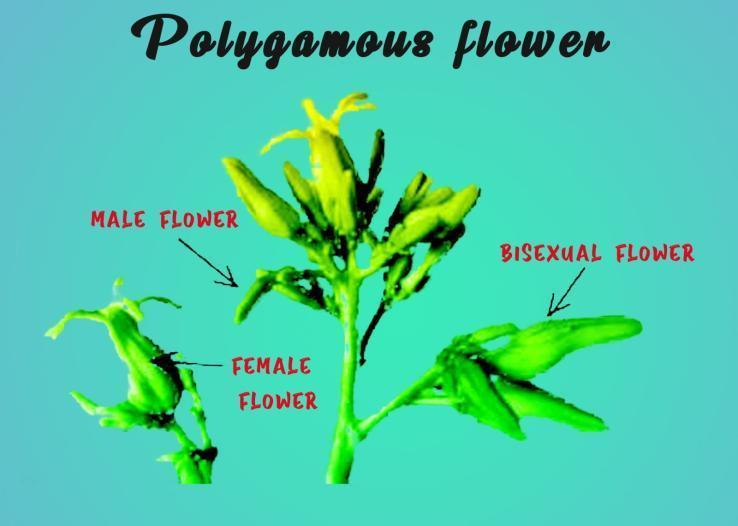
What is polygamous? Give an example.
Answer
493.8k+ views
Hint: The condition in which both the unisexual flowers (having male parts or the female parts in the same or different flower) and the bisexual flowers (having both the male and the female parts in the same flower) are present on the same branch.
Complete answer
The plants consisting of the three types of flowers on the same branch that includes the pistillate flowers (flowers that consist of female parts), staminate flowers (flowers that consist of male parts), and the bisexual flowers are called the polygamous flowers. Examples of these flowers are Banana, Mango, Red maple, etc.
The name polygamous is derived from two words, ply means many and famous means reproductive organs. Overall it refers to the flowers having many reproductive organs in the same plant. It can also be said that the plants containing both the bisexual flowers along with the either male flower or the female flower are said to be polygamous in nature. In the case of the Mango plants, the male and the female flowers are present on the same tree. The flowers of the Mango are white and small that are arranged in the terminal panicle inflorescence. The petals of these flowers are five in number. In these flowers, the chances of cross-pollination are higher as the stamens and the carpels are present in the same flower. The transfer of pollen grains from the anther to the stigma of a different plant is a type of cross-pollination called xenogamy. During this type of pollination, the pollen that come to the stigma are genetically different.

Note:
The polygamous flowers are those flowers that are also called polygamomonoecious or trimonoecious. The flowers that are dioecious in nature and have few bisexual flowers or fee wither male or female plants in the same plant are termes as Polygamodioecious flowers while those flowers that are monoecious in nature and are partly polygamous are termed as Polyganomonoecious.
Complete answer
The plants consisting of the three types of flowers on the same branch that includes the pistillate flowers (flowers that consist of female parts), staminate flowers (flowers that consist of male parts), and the bisexual flowers are called the polygamous flowers. Examples of these flowers are Banana, Mango, Red maple, etc.
The name polygamous is derived from two words, ply means many and famous means reproductive organs. Overall it refers to the flowers having many reproductive organs in the same plant. It can also be said that the plants containing both the bisexual flowers along with the either male flower or the female flower are said to be polygamous in nature. In the case of the Mango plants, the male and the female flowers are present on the same tree. The flowers of the Mango are white and small that are arranged in the terminal panicle inflorescence. The petals of these flowers are five in number. In these flowers, the chances of cross-pollination are higher as the stamens and the carpels are present in the same flower. The transfer of pollen grains from the anther to the stigma of a different plant is a type of cross-pollination called xenogamy. During this type of pollination, the pollen that come to the stigma are genetically different.

Note:
The polygamous flowers are those flowers that are also called polygamomonoecious or trimonoecious. The flowers that are dioecious in nature and have few bisexual flowers or fee wither male or female plants in the same plant are termes as Polygamodioecious flowers while those flowers that are monoecious in nature and are partly polygamous are termed as Polyganomonoecious.
Recently Updated Pages
Master Class 12 Business Studies: Engaging Questions & Answers for Success

Master Class 12 Economics: Engaging Questions & Answers for Success

Master Class 12 English: Engaging Questions & Answers for Success

Master Class 12 Maths: Engaging Questions & Answers for Success

Master Class 12 Social Science: Engaging Questions & Answers for Success

Master Class 12 Chemistry: Engaging Questions & Answers for Success

Trending doubts
What is meant by exothermic and endothermic reactions class 11 chemistry CBSE

Which animal has three hearts class 11 biology CBSE

10 examples of friction in our daily life

One Metric ton is equal to kg A 10000 B 1000 C 100 class 11 physics CBSE

1 Quintal is equal to a 110 kg b 10 kg c 100kg d 1000 class 11 physics CBSE

Difference Between Prokaryotic Cells and Eukaryotic Cells




